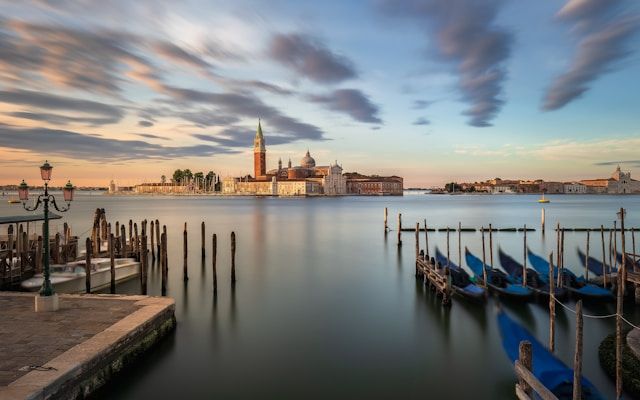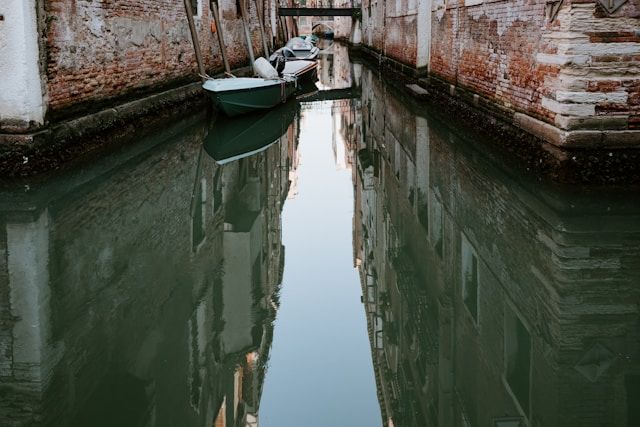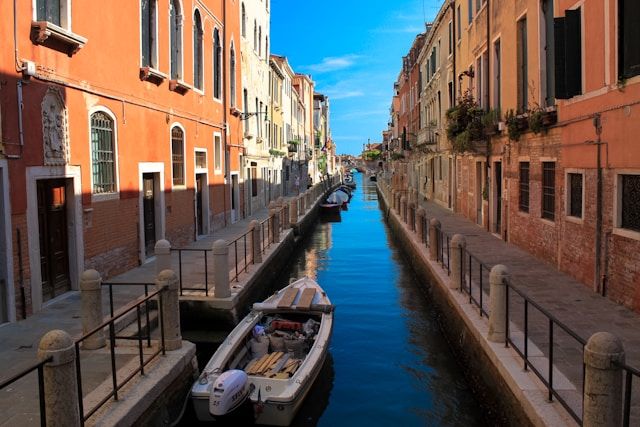Hey traveler! Have you ever dreamed of discovering what lies beneath the enchanted surface of Venice? Maybe you've asked yourself, what does Venice look like under the water? Well, you're in the right place!
In this guide edited by Venice Insider Guide, we'll take you through the underwater mysteries of Venice, exploring what lurks beneath its canals and how this floating city continues to defy the laws of nature.
That's right: we will discover together the most frequently asked questions about underwater in Venice.
What does Venice look like under the water

Venice is famous for its glittering canals, romantic bridges and gondolas gliding slowly over the water. But there is a legitimate question of every traveler or lover of this city floating on water: what goes on beneath the surface of Venice?
Beneath the canals of Venice lies a hidden world: a network of wooden poles, silt and ancient structures that support the city. Water is both a vital element and an enemy: it corrodes foundations and requires constant restoration.
So, what does Venice look like under the water? Let's find out the details of underwater in Venice.
Submerged foundations
Venetian houses rest on wooden poles driven into the muddy ground. These poles, mostly oak and larch, do not rot because they are completely submerged in oxygen-free water. It is a delicate, but surprisingly solid balance: without this foundation, Venice would not exist.
What does Venice look like underneath?

Now, let's clarify a doubt. Underneath does not only mean “under the water,” but also “beneath the surface of the city.” Imagine a kind of hidden Venice, made up of submerged corridors and ancient structures.
What else to know about on underwater in Venice?
Let's better answer the question what does Venice look like underneath.
The hidden layers of history
Many Venetian buildings conceal submerged underground spaces within them. These spaces, once warehouses or visible foundations, have been invaded by water over the centuries. It is like walking on a palimpsest of history: each palace has one foot in the past and one in the present.
What does Venice look like under the water?

There is a poetic and eerie aspect to thinking about Venice beneath the surface. From old shipwrecks to underwater structures, the water holds centuries-old secrets. But what can you really see if you dive?
Marine life in the canals
What does Venice look like under the water? Yes, there are creatures living in the canals! Small crabs, eels and a few curious fish populate the Venetian waters. Also, under the water, the walls of buildings are often covered with algae and mollusks, silent witnesses to the passage of time.
What to know: the water in Venice is rather murky, so exploring the seabed does not offer crystal-clear visibility. However, there are guided dives in more open areas, such as the lagoon.
What did Venice look like before the water?

Here's a real history buff's question: what was Venice like before water? Surprisingly, the answer is "it never existed without it"!
Venice before it was Venice
Before the 9th century, the area where the city stands today was an expanse of islands and marshes. The first settlements were created by people fleeing the barbarians, who found refuge in this inaccessible area. In time, the islands were joined, poles were planted, and the Venice we know today was born.
What does Venice look like under the water today?

Today, submerged Venice tells a story of adaptation and resilience. The wooden poles are still there, holding out against all odds, but the battle against time is relentless.
The threat of high water
High water is a modern challenge that shows how fragile this urban ecosystem is. With the MOSE project, a series of mobile dams protect the city from storm surges, but the future remains uncertain.
What to consider: taking a boat tour with an experienced guide allows you to discover unique details, such as hidden inscriptions on bridges or spots where high water has left its mark.
What do the foundations of Venice look like?
Ah, the foundations of Venice, true unsung heroes. But what is special about these poles?
An engineering miracle
The foundations of Venice consist of millions of wooden piles planted vertically into the muddy ground. On top of them are layers of stone and brick that create a stable foundation. It is a system that has endured for centuries but requires constant maintenance.
To know: although the poles are made of wood, they harden over time due to water calcifying the material. This natural process has turned wood into a kind of stone.
How deep is the water in Venice?
Practical and fundamental question to understand how this city works. The depth of the canals in Venice varies greatly.
How deep is the water in the canals?
In the main canals, such as the Grand Canal, the depth reaches 5 meters, enough for large boats. In smaller canals, however, the water may be only 1-2 meters deep.
Fun fact: Some areas are so shallow that gondoliers have to be careful not to touch the bottom with their oars.
Underwater Venice and the rising tide: what the future holds for the floating city

What does Venice look like under the water? Oh yes, dear traveler: this question for Underwater in Venice has become increasingly important as Venice, Italy—a city built atop the shallow Venetian Lagoon—faces the growing threat of rising sea levels.
The city's famed canals, including the Grand Canal, and its iconic landmarks like Piazza San Marco and St. Mark’s Basilica, are at the forefront of this crisis. Venice's buildings, many of which date back centuries, rest on wooden foundations submerged in the lagoon, a wetland environment that could soon become more of a challenge than a charm.
Rising sea levels, fueled by climate change and high tides, are causing severe flooding across Venice, and more than half of the city could be submerged in the coming decades.
The situation is worsened by the sinking of the city itself under its own weight, pushing down the soil and exacerbating coastal flooding.
According to a study by Italian scientists, the relative sea level rise is accelerating, with the Adriatic Sea’s average depth contributing to the increasing severity of this problem.
To protect Venice, mobile barriers are being implemented along the lagoon to help prevent high tide floods from reaching the city’s historic heart. However, the challenge remains significant, as canals, which would seemingly restrict travel, are also vulnerable to the effects of sea level rise.
It’s a unique and unforgettable scene: the waters carve their way through the city’s 400 bridges, and tourists on a gondola canal tour may soon find themselves wondering if the next trip could be to a Venice completely underwater.
Imagine Venice as a tropical island, where the canals and watery expanses have been the lifeblood of the city for centuries. Yet, climate change and the ever-looming rise in sea levels could change Venice’s future dramatically.
Tourists who visit Venice, Italy, and walk through Mark's Square, or take a tour of the Doge’s Palace, may find that the historic scene is no longer quite as it once was. As scientists continue to study the impact of climate change, including those at Western New England University, the city’s survival will depend on concerted efforts to slow the forces that threaten this globally renowned scene.
Venice, Italy: A City like no other
Venice, Italy, is unlike any other city in the world. Built on a series of islands within the Venetian Lagoon, it has long been known as a floating city, with its buildings resting on wooden pilings that are submerged in the water.
This unique geographical location, along with its intricate network of canals, makes Venice a mesmerizing place to visit, offering a blend of history, art, and architecture that few cities can match. Whether you’re walking through the narrow alleys, cruising along its famous waterways, or visiting its world-renowned landmarks, Venice, Italy, presents a scene that is both magical and fragile, constantly battling the forces of nature to remain afloat.
The venetian lagoon: A shallow and vital ecosystem
The Venetian Lagoon, surrounding the city of Venice, is one of the most important natural features of the area. This shallow lagoon, which spans about 550 square kilometers, is a unique and fragile ecosystem that has been home to a diverse range of flora and fauna for centuries. It’s also vital for Venice’s existence, providing protection from the Adriatic Sea’s harsh waves.
However, the lagoon is also at risk from rising sea levels, pollution, and human intervention. Its saltwater channels, mudflats, and marshlands are key to Venice's balance, supporting its distinct wetland environment. Protecting the Venetian Lagoon is not only crucial for preserving the city itself but also for maintaining the biodiversity that thrives within it.
The Grand Canal: Venice’s majestic waterway
The Grand Canal is the lifeblood of Venice, Italy, winding its way through the heart of the city and serving as its main waterway. At over 3 kilometers long, this iconic canal is flanked by beautiful buildings dating back to the 13th century, many of which are decorated with intricate frescoes and luxurious marble facades.
Historically, the Grand Canal was the primary trade route, and today it is a vibrant hub for both Venetians and tourists alike. Visitors can take a grand gondola canal tour, cruising along the canal’s calm waters and soaking in the spectacular views of Venice’s most famous landmarks, including the Rialto Bridge and the Ca’ d’Oro. The Grand Canal is truly a marvel of engineering, and it offers a glimpse into the city’s rich history and culture.
Venice, Italy: A City of art, history, and resilience
Venice, Italy, is a city that embodies the elegance of the past and the resilience required to face an uncertain future. With its elaborate palaces, intricate architecture, and renowned art collections, Venice has earned its place as one of the most historically significant cities in the world. The city’s well-preserved art and architecture paint a vivid picture of a time when Venice was a powerful maritime republic.
Despite the threats posed by rising sea levels, severe storms, and the weight of its own history, Venice continues to draw millions of visitors each year who come to experience its unique charm. Whether you're walking through St. Mark's Square, visiting the stunning Saint Mark's Basilica, or enjoying a peaceful gondola ride, Venice remains one of Italy's most unforgettable destinations.
Underwater in Venice: Conclusion

Here we are at the end of our journey, curious traveler! Venice is not just what you see on the surface: it is a layered city, a jewel suspended between history and engineering, water and land.
To recap for Underwater in Venice:
- Beneath the canals lies a world of wooden poles and silt that holds up the entire city.
- Before water, Venice was an archipelago of marshy islands.
- Today, its submerged foundations tell a story of resilience against time and tides.
So the next time you are in Venice, look beyond what is visible. Remember that every drop of water hides a fragment of history, every bridge is a passage between past and present. And if you still wonder what does Venice look like under the water?, the answer is simple: it is a world of mysteries just waiting to be discovered.

